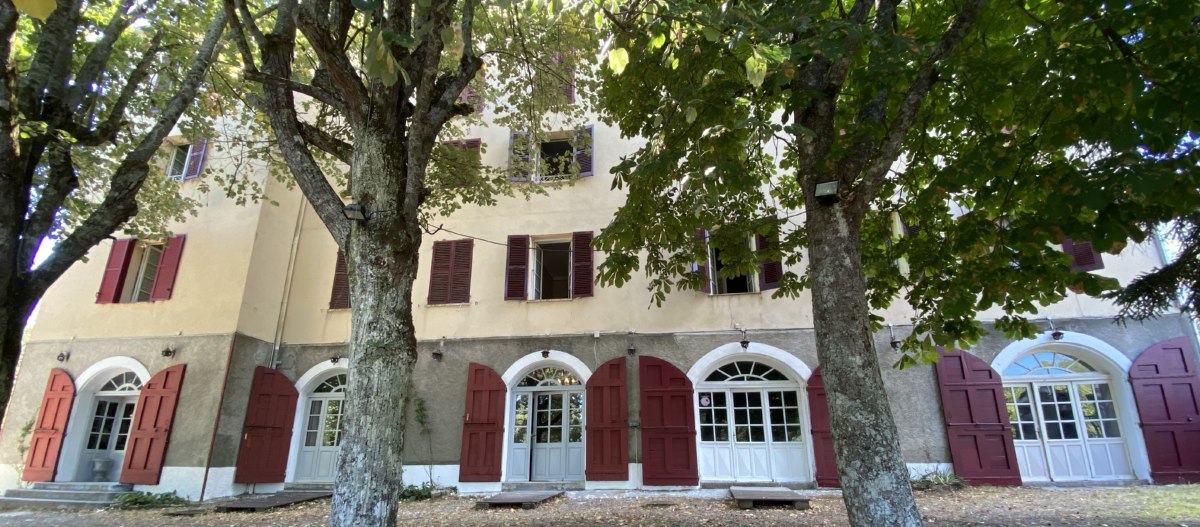
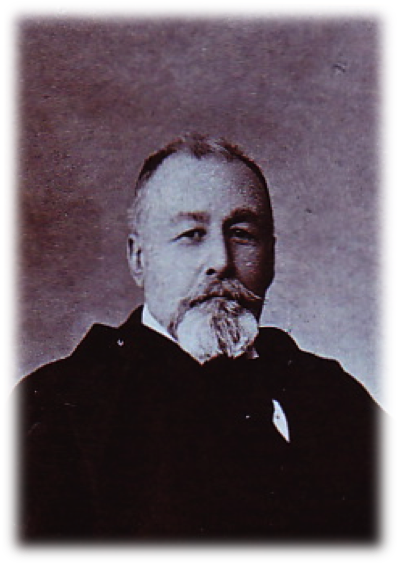 Count François-Xavier Pozzo di Borgo 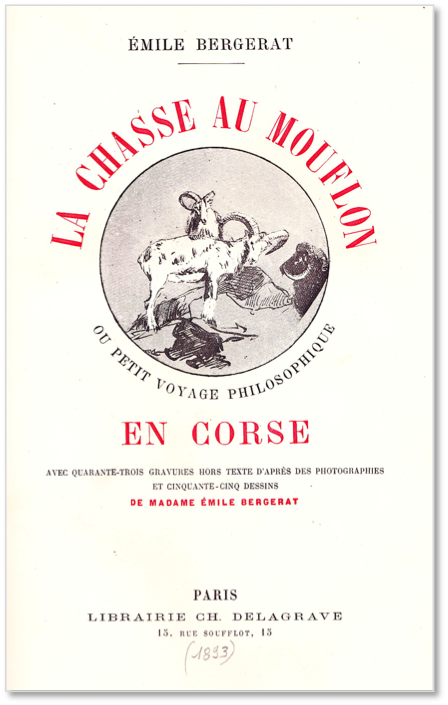 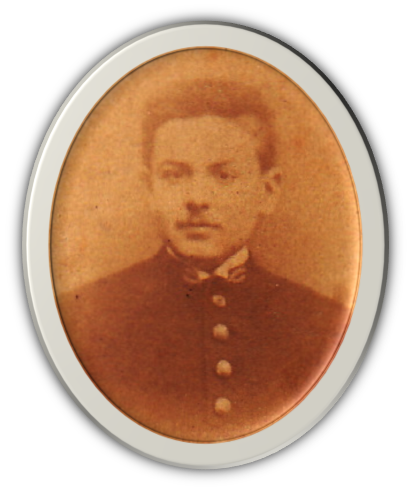 Paul Pozzo di Borgo |
The house was built in Santo Pietro di Venaco in the second part of the 19th century by Count François-Xavier Pozzo di Borgo (1837-1907), grandnephew of the famous Charles André Pozzo di Borgo (1764-1842). They, a diplomat, ambassador to France of Tsar Alexander of Russia, is best known for having been Napoleon's enemy.
At first, the building had the appearance of a three-storey chalet, with two large carraige doors opening onto the stables. It was built by the heir count who had called on several doctors to locate a place in Corsica that would be favorable to his asthmatic health. It was the Venacais that was chosen because of its mild climate. The chalet was designed as a mountain house, in which the Pozzo di Borgo family and their in-laws, the Peraldi, could stay. In this bucolic setting, at more than seven hundred and fifty meters above sea level, dominated by the Mount Cardo (2453 m) and lulled by the sound of the neighboring torrent - the Misognu - the count had alleys of lime trees and pines planted. It also built shaded squares and a park with many tree species (maple, chestnut, alder...), all in the middle of centuries-old chestnut trees. When in 1883, Duke Jérôme Pozzo di Borgo (1832-1910) began to build the castle "de la Punta" in Alata with the stones of the Tuileries, his brother - Count François - had just finished his: a new building perched on the hill of Saint-Pierre-de-Venaco, a few hundred meters from his chalet. After the construction of the castle of Saint-Pierre, the chalet continued to be inhabited by the families of Count Pozzo di Borgo and Count Peraldi.
* * *
In 1887, the writer Émile Bergerat (1845-1923), nephew of Theophile Gautier, stopped on the lands of Pozzo di Borgo in Saint-Pierre-de-Venaco. He is accompanied by Prince Roland Bonaparte, botanist and grandson of Lucien Bonaparte. His wish would have been, he says, "to witness a very French reconciliation between Napoleon's grandnephew" and those of Charles André Pozzo di Borgo "who would have made his noise in the world"* The writer, who dared to knock on the door of the count's house, was photographed under the "monster" chestnut trees - as he calls them - of the "Nepita", in front of the summer cottage. There, he began to say: " Pozzo's implacability was frightening. His tenacity equals that of Ulysses, to whom he resembles, and whose nomadic life he renewed, a true odyssey of hatred, who has not yet found Homer. When the Eagle fell in St. Helena, flapped its wings and died, Pozzo di Borgo, who had thrown it there, again uttered a cry of joy in the storm: "It was not I who killed little Bonaparte, but I bury him! God be blessed! ” And in fact he survived him twenty-one years, sad, sick and as idle to no longer have his enemy. Ah! what a Corsican still this one, and what an epic vendetta that the life of this diplomat! He appears to me above all as a type of the great indigenous lord, the clan leader, and this is how I evoke him under the colossal chestnut trees (the oldest in Corsica) of his domain of Venaco. But what did Napoleon do to him, to this Carlo-Andrea? We wonder. On one of the huge chestnut trees — of a perimeter of nine meters and a half and a concordant height, — we collected a mushroom as big as a child's umbrella. He lived there, this parasite, in addition to the sap of the colossus, and perhaps was he jealous of it! Our coachman asked us to give it to him if we didn't do anything about it. "We eat them in Corsica," he told us. They are not worth chestnuts, but they have a bit of a taste, and in an omelette it's a treat of the country! ” We left him his Pozzo di Borgo... I mean his cryptogame. »**
* * *
At the end of the 19th century, the count's family, the Peraldi, as well as friends and guests, continued to stay at the summer cottage. In 1895, Paul Émile, the only son of Count Pozzo di Borgo, died at the age of 19, following a horse accident.
* Émile Bergerat, La chasse au mouflon ou petit voyage philosophique en Corse, Librairie Ch. Delagrave, 1893, p. 107.
Poet and playwright, highly represented during his lifetime, Émile Bergerat was also a columnist in the Voltaire and Le Figaro newspapers, as well as a member of the Goncourt Academy. ** Ibid., p. 111
.
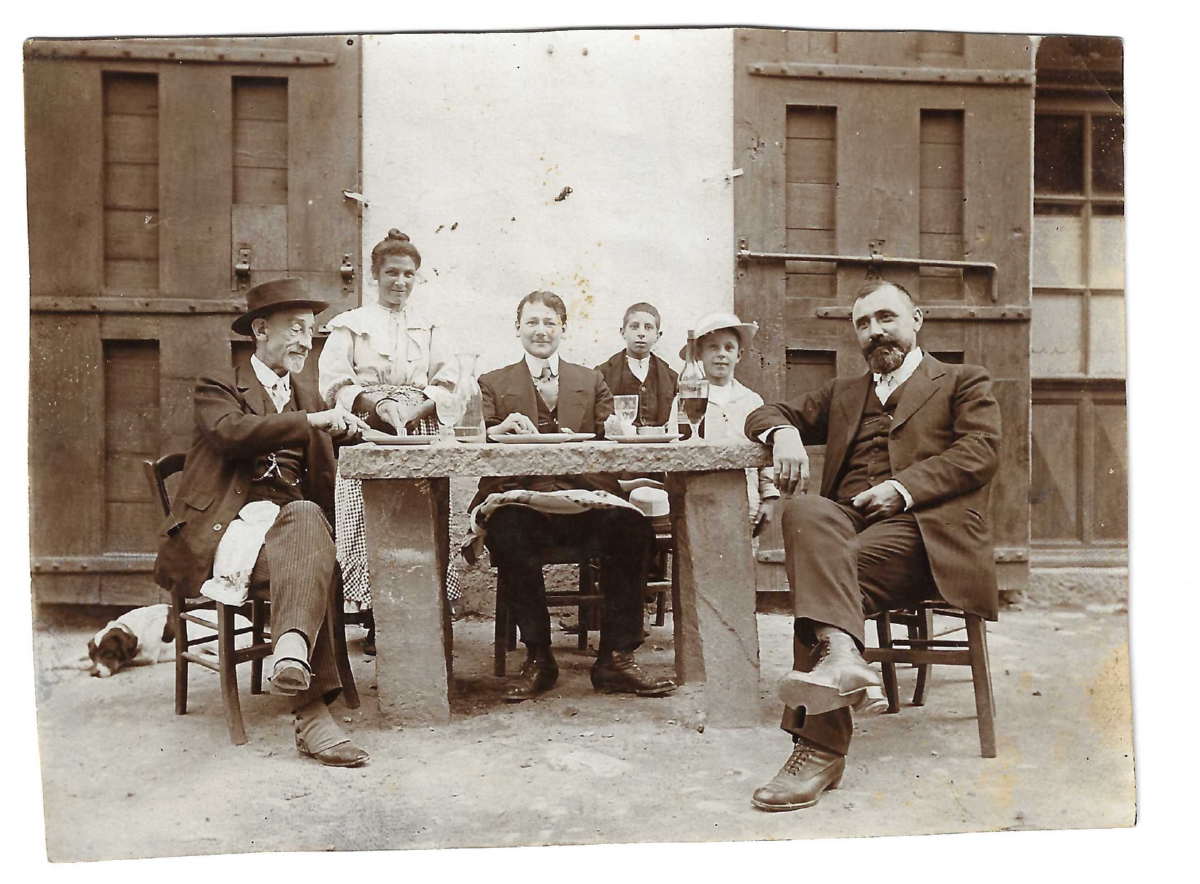 F-X. Pozzo di Borgo seated on the right. |
|
The "monster chestnut trees" in the field called "a Nepita", in Santo-Pietro-di-Venaco (Cf. Émile Bergerat,
La chasse au mouflon ou petit voyage philosophique en Corse, Ibid., p. 109).
These remarkable trees were cut down after a disease that ravaged the region in 1907. However, there are still a few centuries-old chestnut trees in the valley of the torrent and on the place called "a Nepita". Photo on the right: Emile Bergerat and Roland Bonaparte on the field called "A Nepita", in front of the Hôtel du Torrent. |
 |
|
.
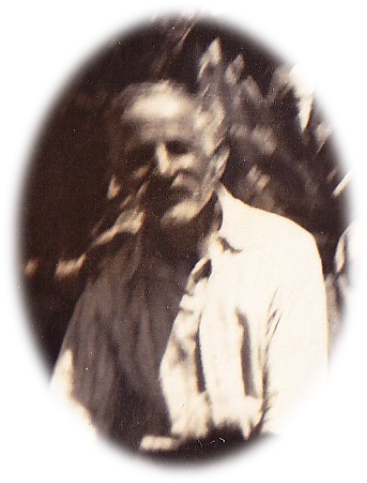 André Mariani |
In 1896, the building was transformed into an inn by André Mariani. They - whom Count Pozzo di Borgo now considered like his son - became the first saucian in France. In 1898, he officially founded the "Hôtel du Torrent". The site, halfway between Ajaccio and Bastia, was an ideal stop for travelers from Corsica and elsewhere. The hotel, as well as its gourmet restaurant, quickly gained a reputation at the end of the 19th century when Corsica became very popular with English and continental tourists, attracted by the beauty of the island landscapes. |
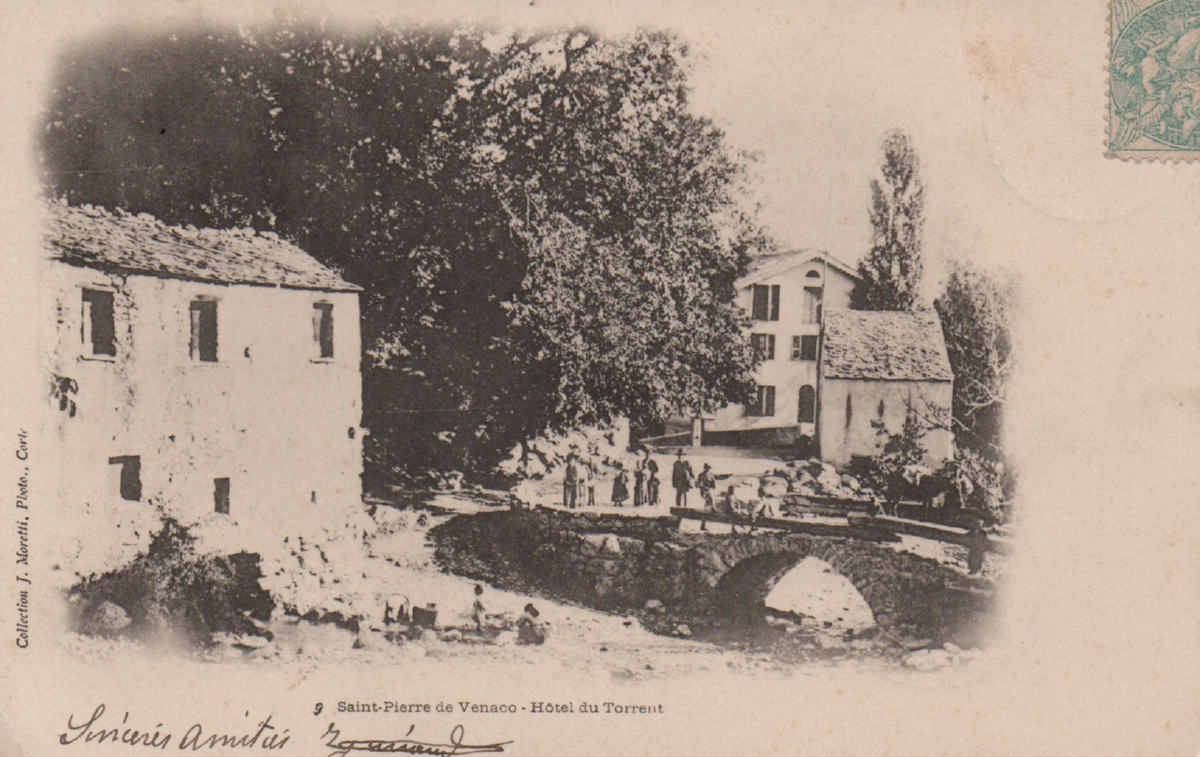
The hotel du Torrent, early 1900 (photograph by Joseph Moretti).
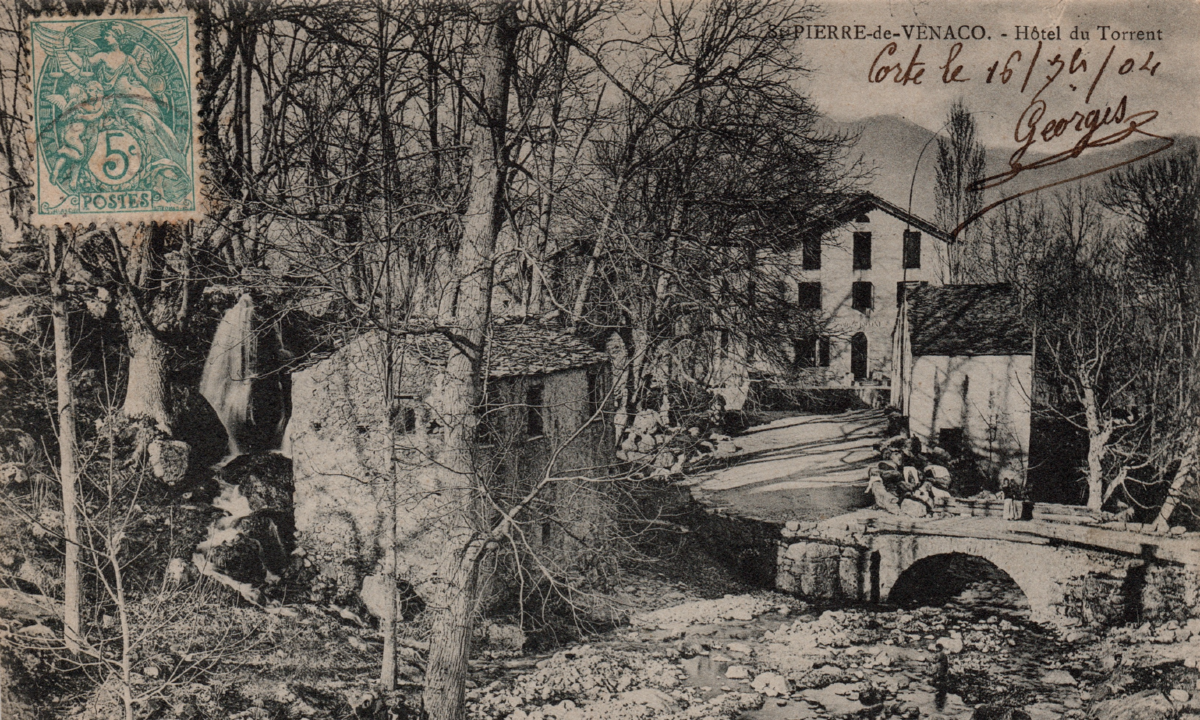
1904
(photograph by Joseph Moretti). . 
1911
|
With the summer, many Corsicans left the coastal areas for the mountains, where the air was cooler. The Hachette Guide of 1915 presents the Hôtel du Torrent as a summer resort where the Ajacciens could thus stay on board in "furnished apartments".
The train facilitated travel and, for customers who were getting off at Venaco station, they were offered to pick them up in a small cabriolet for the modest sum of 2 francs 50. Note that the pension was more expensive in winter (7 francs) than in summer (6 francs), in particular because of the cost of heating. Located in the heart of Corsica, the Hôtel du Torrent was popular with the notables of the island. With great comfort, there was water a every floors and the telephone (which was rare at the time in the central villages). The Guide de la France Sud-Est (Hachette) of 1929 specifies that the hotel is "in a nice location" and that it is a "pretty, very busy summer stay". 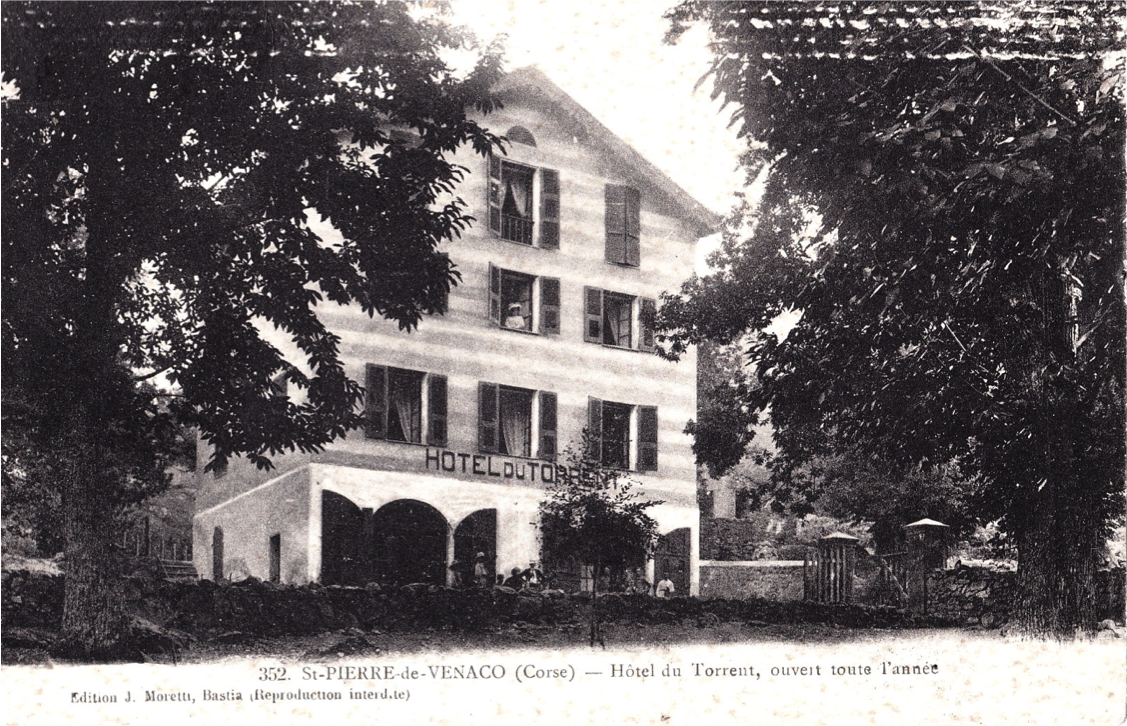 |
|
.
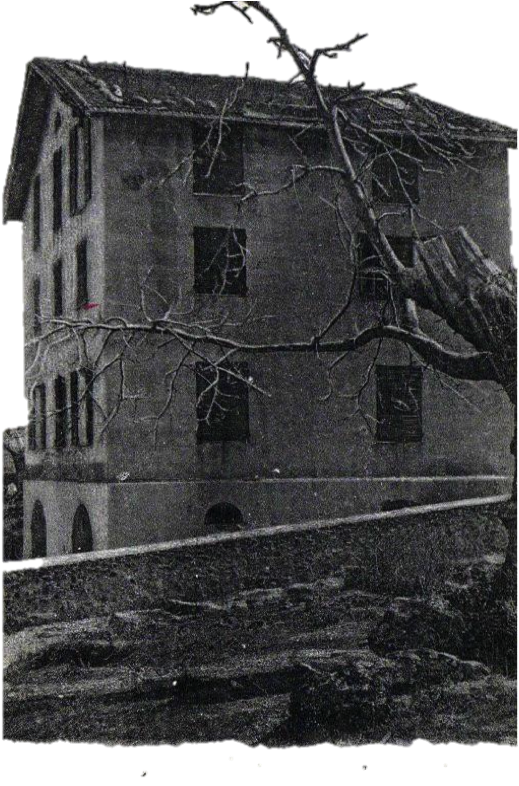 Postcard of the Hôtel du Torrent, published by Pergola. 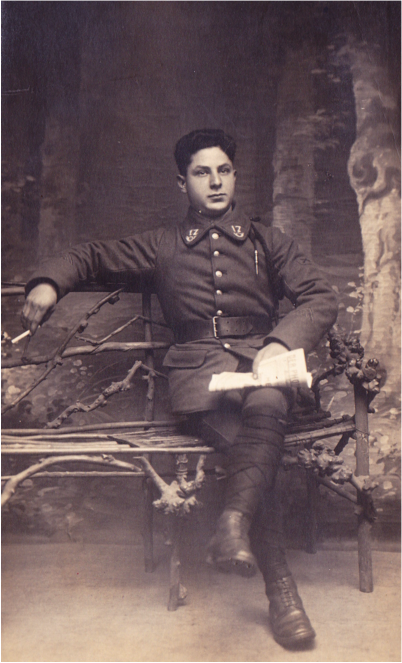 Mathieu Mariani, Mathieu Mariani,son of André Mariani. |
When the Second World War broke out, Corsica was occupied by Italians and Germans. In 1942, the Italian army staff established its headquarters in Corte, while the aeronautics command requisitioned the rooms of the Hôtel du Torrent.
On October 5, 1943, Corsica was liberated. On October 8, Charles de Gaulle arrived in Ajaccio. The general spent three days on the island. On his journey along the national road, he was welcomed by the roadside, in the hotel park, by the Gaullists who supported him, including the Mariani family.
* * *
At the end of the Second World War, the family business was taken over by Marie-Françoise born Grimaldi (1915-2004) - affectionately called "Fanfette" - and her husband Mathieu Mariani (1903-1980). They, son of the late André Mariani, had retired as a non-commissioned officer, following a fifteen-year military career, begun during the Rif War and continued in the colonial, especially in Indochina.
* * *
In 1960, the couple bought the establishment from the Donati family, who had acquired the property of the Pozzo di Borgo in 1917. 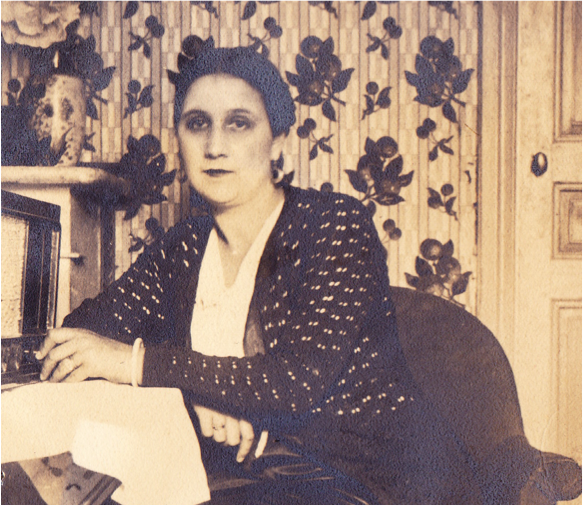 Marie-Françoise, born Grimaldi, married Mariani. |
|
.
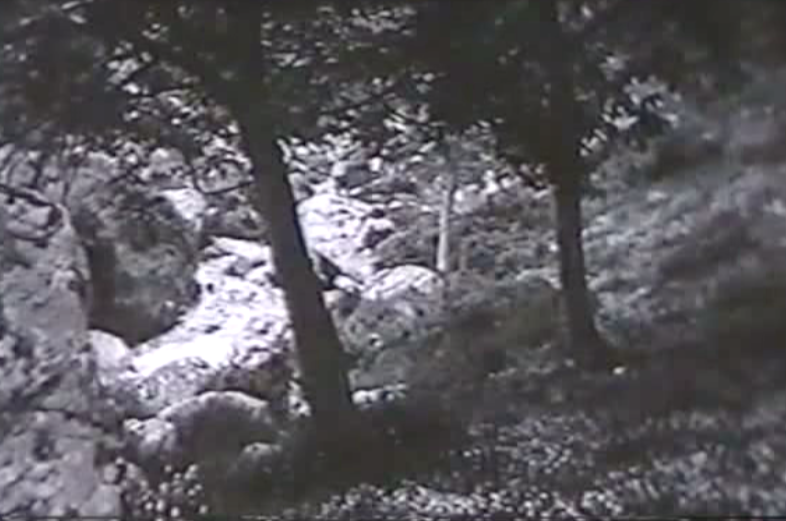
The Torrent "U Misognu". Photo of the film Le Refuge by Léon Mathot (1930).
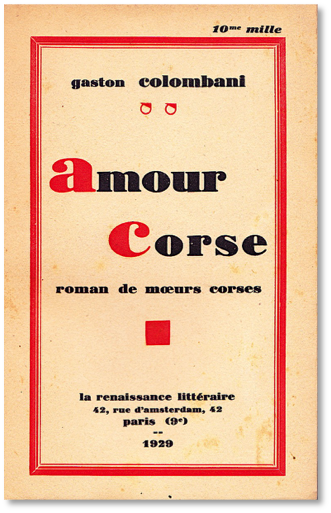    Excerpts from Amour corse, by Gaston Colombani 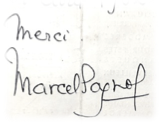 Dedication of Marcel Pagnol, August 1962 |
Throughout the 20th century, the hotel-restaurant was frequented by writers and artists.
In 1929, this "dream place" with "spacious and fragrant rooms" inspired several pages of Gaston Colombani's novel Amour corse (1875-1936)*. The last night spent at the hotel by the protagonists of the story is described as follows: "Only the sound of the torrent next door disturbed the silence of the place. The air was overloaded with aromas. However, the soul still imbued with this evening poetry, the young people went to bed, not without wanting to keep the windows open, in order, they said, to let the refreshing kiss of the spaces enter their room and on their sleep."**. A year later, some scenes from the film Le Refuge de Léon Mathot are shot near the Hôtel du Torrent. The team stays there to film the course of Misognu, the mountains, alleys and natural landscapes of Saint-Pierre, Lugo and Poggio di Venaco. In this hotel, there was also the one nicknamed "U Sampetracciu": in addition to being the founder of the theater di A Muvra, a remarkable Corsican writer and poet, Ghiannetu Notini (1890-1983) was also an admirable tango dancer. In the 50s and 60s, he was a regular at the cabaret-disco library that the Mariani spouses had created at the "annex" of the Torrent. This ebony-haired black customer remained loyal to the hotel until his death. * Gaston Colombani, Amour corse, roman de mœurs corses, La renaissance littéraire, Paris, 1929 (Cf. pp. 223-230), pref. by Paul Brulat. Gaston Colombani was a writer, journalist, founder and director of the Cri de France and Paris-Corsica newspapers. ** Ibid., p. 230. In the 1960s, the writer and filmmaker Marcel Pagnol (1895-1974) could be seen on the terrace of the restaurant, in the shade of the lime trees. In the same vein, José Giovanni (1923-2004) moved to the Hôtel du Torrent in 1966 to shoot some scenes from La loi du survivant in Corte and its surroundings. He stayed for several days, accompanied by his team and actors Michel Constantin and Alexandra Stewart. Room No. 16 of the old hotel then served as the setting for the film. Because he had family origins in Saint-Pierre-de-Venaco - including his grandmother Faustine Tomasi, born Ristori, a relative of the Mariani family and wife of photographer Ange Tomasi (1883-1950) - comedian Philippe Léotard came to boarding house at the Torrent, especially with Nathalie Baye or Bernard Lavillier. The same was true for his brother, former Minister François Léotard. Other artists frequented the establishment, starting with Corsican singers and musicians: Jean-François and Alain Bernardini of the group I Muvrini (they gave concerts in the 1980s in the so-called "a Nepita" field), Antoine Ciosi, Maryse Nicolaï, Jean-Paul Poletti, Regina and Bruno, Charles Rocchi, Tino Rossi, etc. Many personalities were used to the place. Not all of them can be mentioned. Let us note only one exception: the former President of the Republic, Georges Pompidou, who as a simple customer had come to eat fritelle (fritter) directly in the kitchen of the old hotel. His wife Claude will return regularly after her husband's death in 1974.
* * *
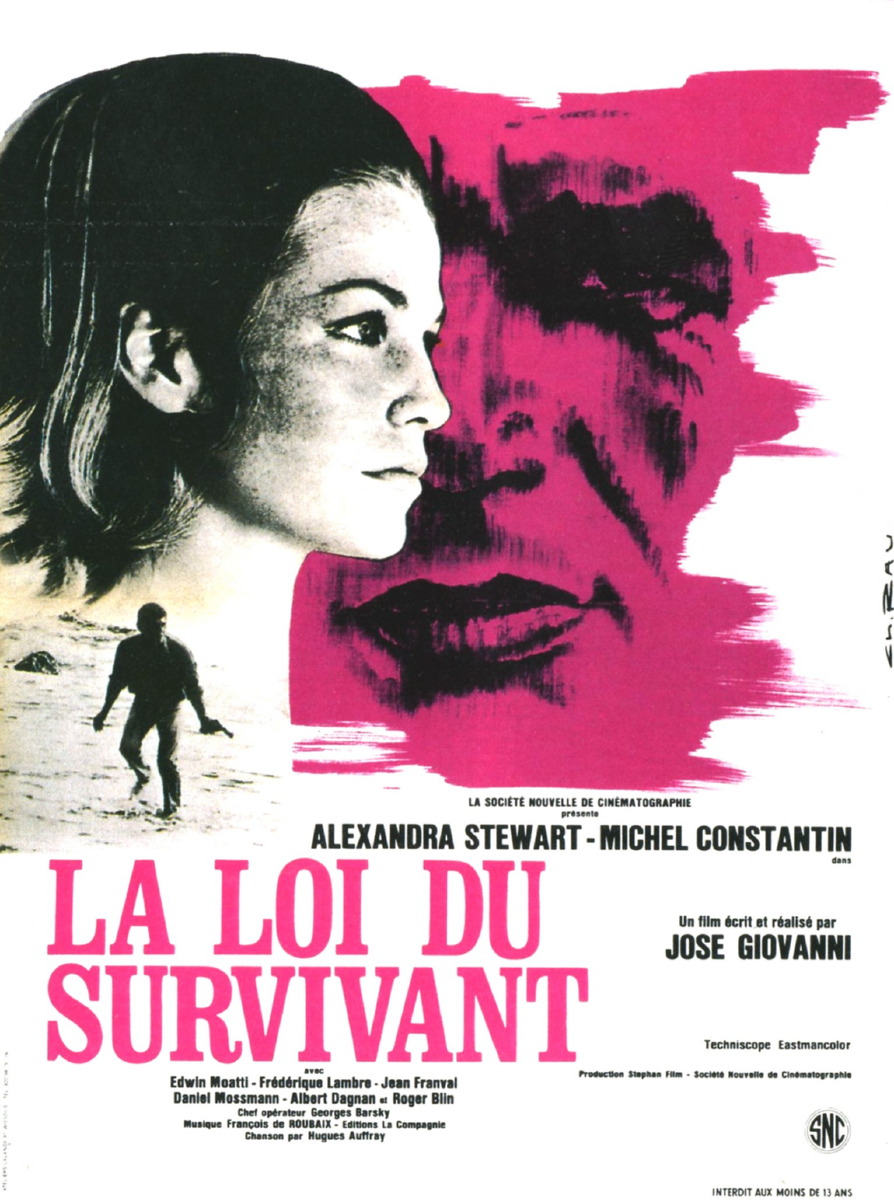 |
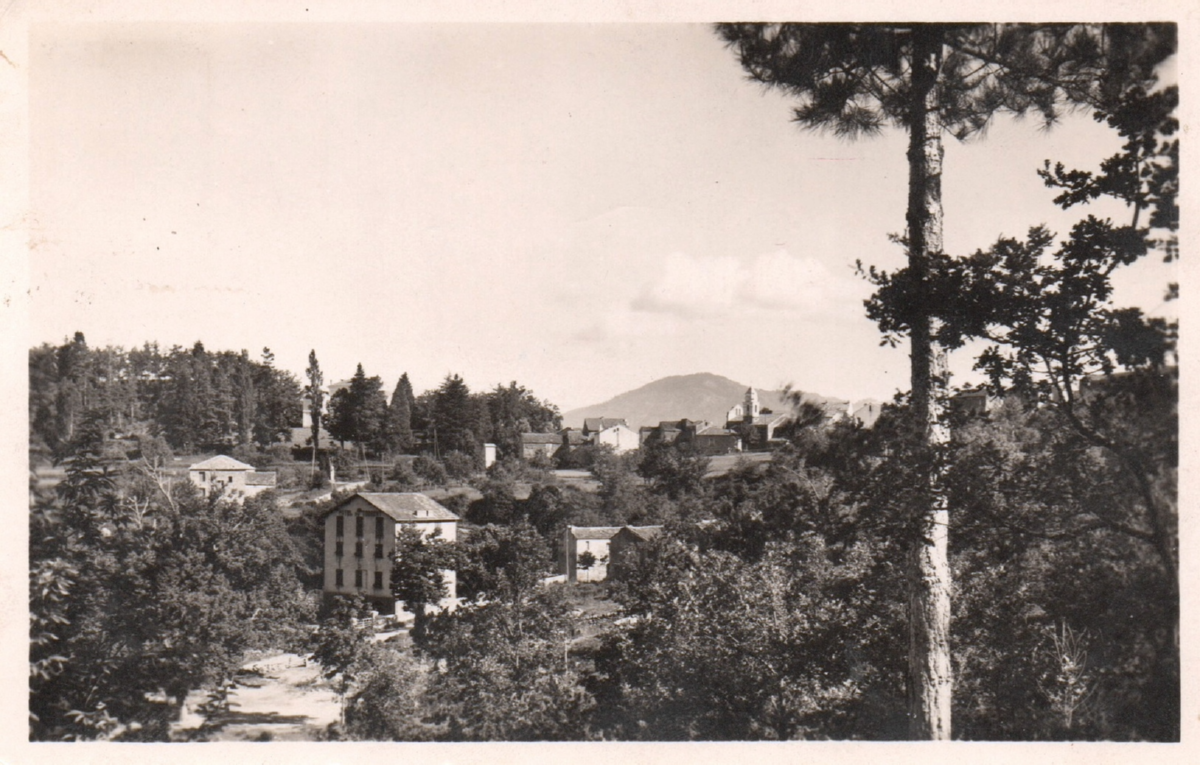
|
.
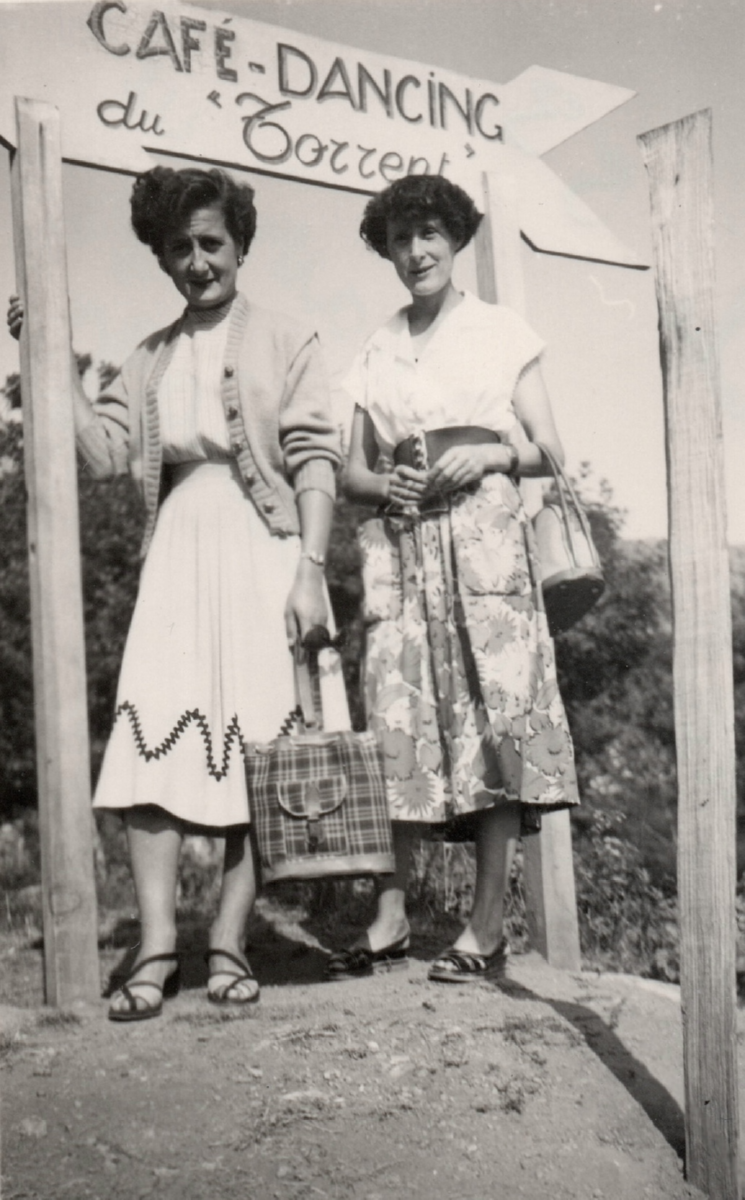 Girls from Riventosa go to the Torrent dance club (1953, © Thér. Ottaviani) |
In the 1950s, Matthieu and Marie-Françoise Mariani inaugurated the "dance club" of the Torrent which was, at the time, one of the few night clubs in the center of the island. And it is no surprise that the place quickly attracts a large crowd from all over Corsica. The dance floor is located in the hotel annex, near the national road. Just above, the rooms annexed to the hotel are rented despite the sound of the music. But no one complains. Dancing is appreciated by all. The youngest come to dance rock'n'roll, while the oldest repeat the steps of waltz, tango or paso doble. The dancing years of the Torrent will last until the end of the 1960s. For two decades, the girls and boys of the villages will meet there... under the eyes of their parents who came to watch them. 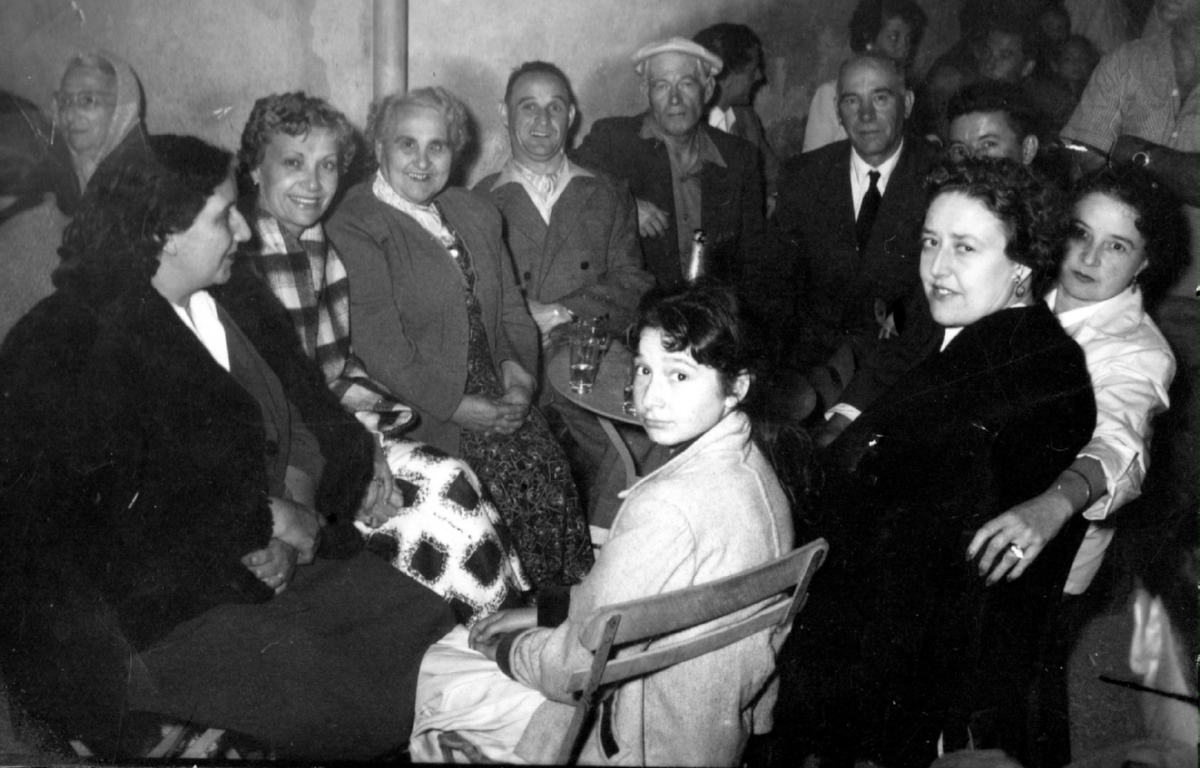 While the young people are dancing, family and friends are seated near the track. |
|
.
 Below, the hotel before transformation (coll. Mariani) 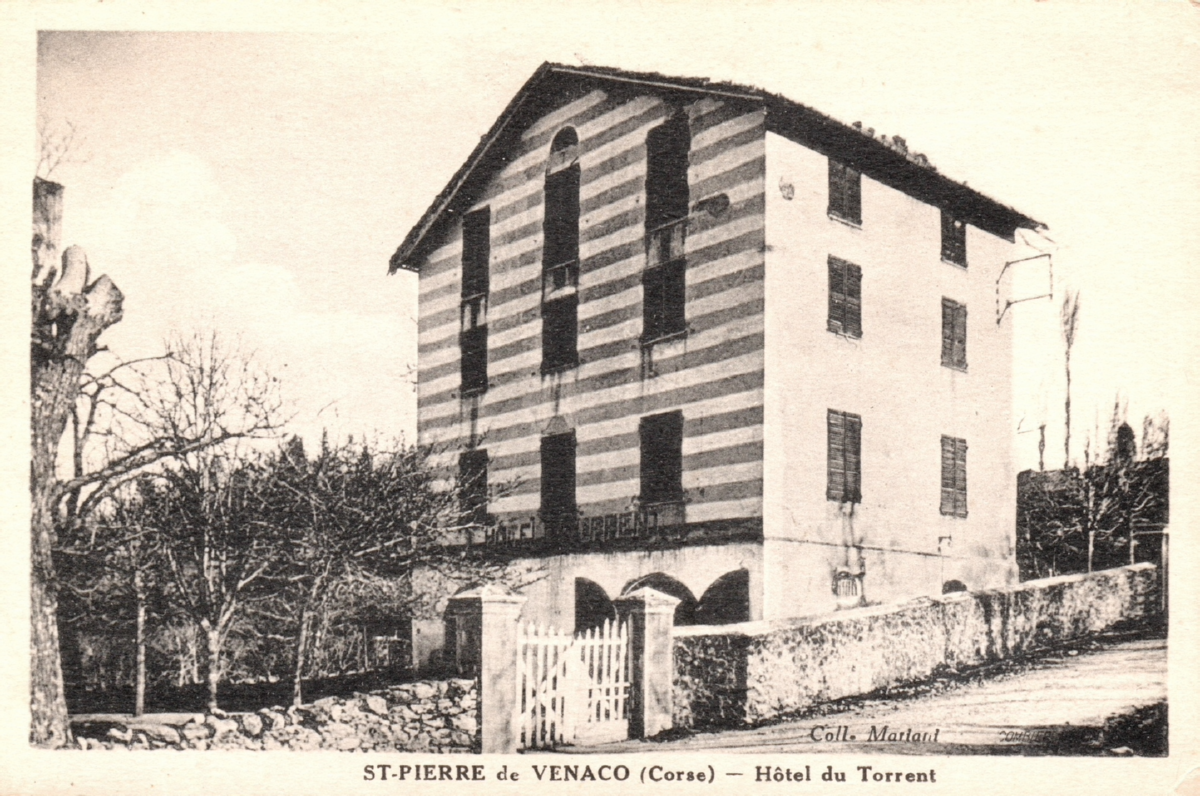 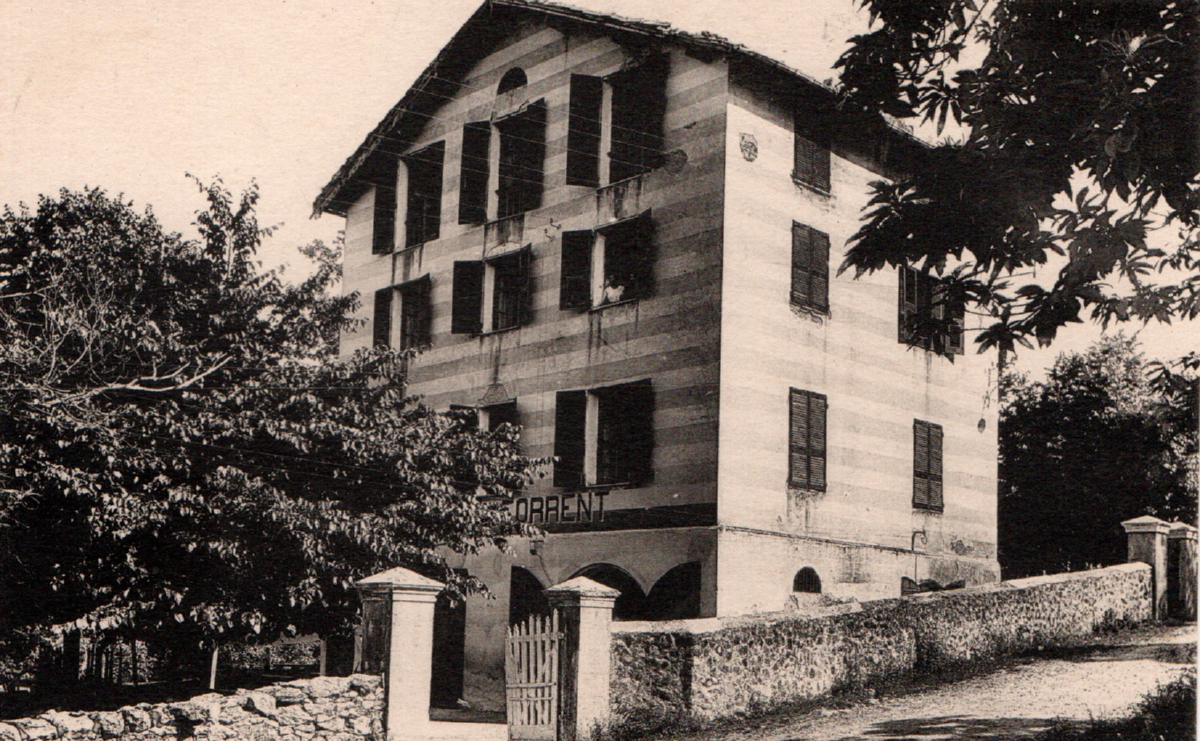 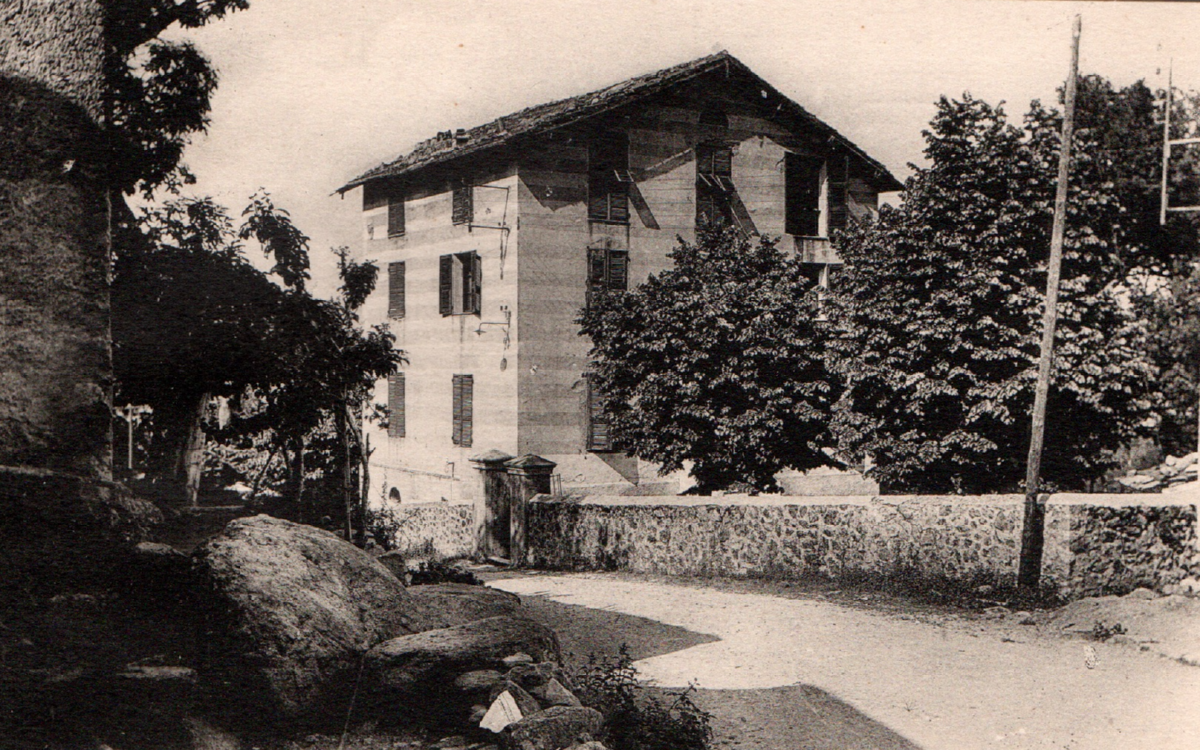 |
From the 1960s, the building was enlarged several times.
The Hôtel du Torrent has also been refurbished. The ground floor and the first level are increasing in area and four large fitted doors now adorn the facade. Owners Marie-Françoise Mariani and her husband Mathieu transform the dancing club into an hotel annex. In the 1970s, the building was again elevated to form its definitive appearance: a building of about forty rooms rising over three floors, with an exterior face composed of five carraige doors and a rectangular tower. This extension constituted the new hotel with rooms built in separation from the old building, also called the old hotel. 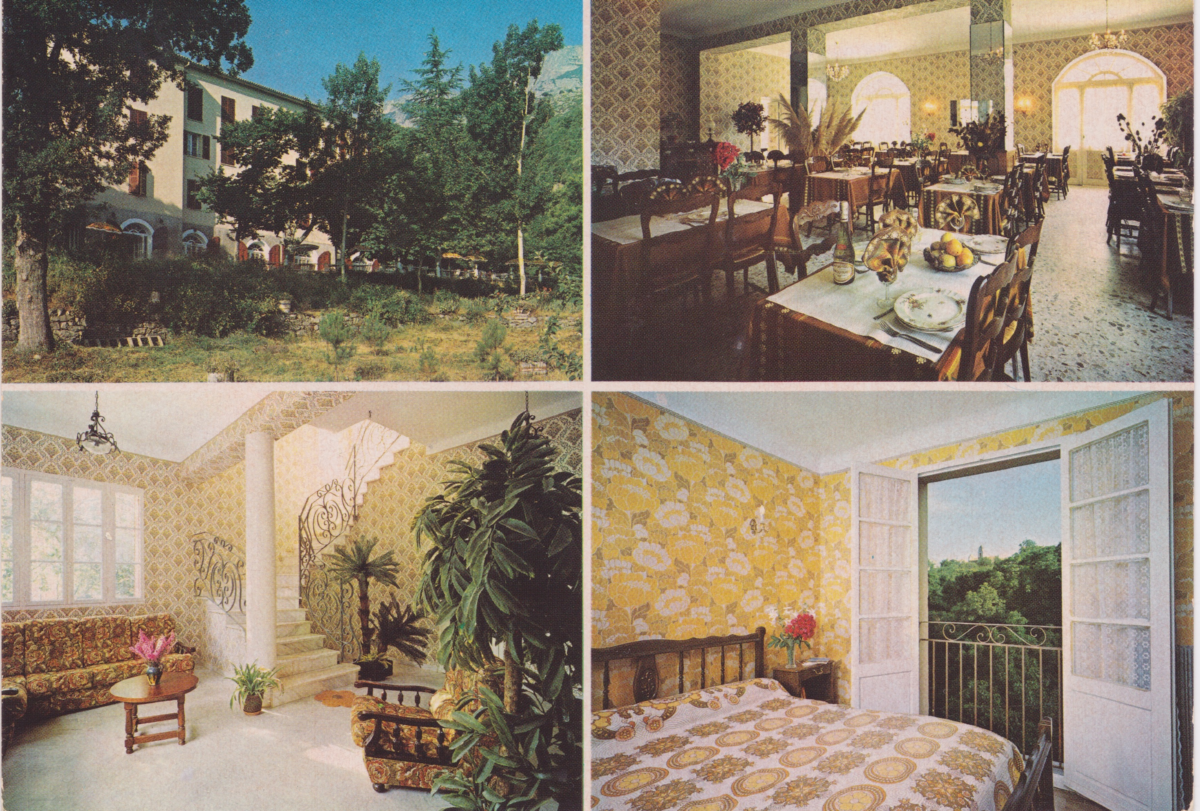 Postcard from the 1970s Postcard from the 1970s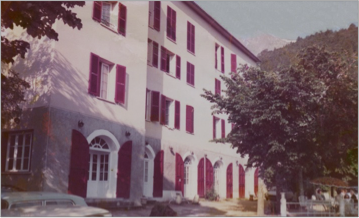 The Hotel Restaurant Le Torrent in the 1980s. |
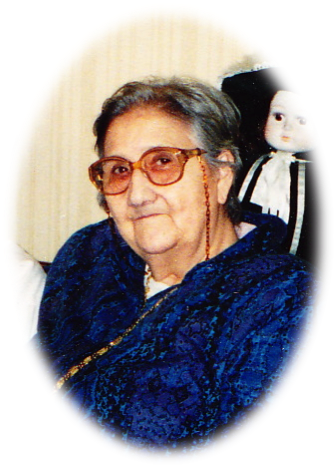 Marie-Françoise Mariani, born Grimaldi (photo taken in 1990). |
After the dead of her husband in 1980, Marie-Françoise Mariani, known as "Fanfette", was the sole owner of a hotel she manages with her two daughters, Marie-Lucie and Madeleine, and son-in-law, until her death on January 4, 2004. The Hôtel du Torrent in 1978. Interview with Marie-Françoise Mariani. |
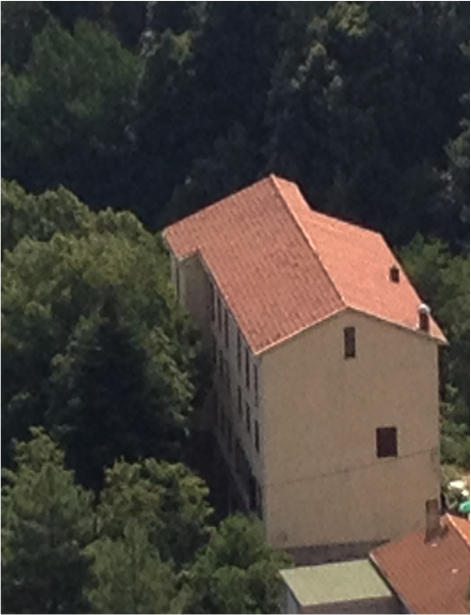 .  The hotel's large park
The hotel-restautant Le Torrent, seen from the sky
|
In 2004, upon the death of Marie-Françoise Mariani, the hotel-restaurant "Le Torrent" was leased. To date, it is one of the oldest hotels in Corsica still in operation*. * Thierry Ottaviani, La Corse pour les Nuls (Corsica for Dummies), éd. First, 2010, p. 205.  The hotel square and its lime trees. Photo taken in the early 2000s.
|